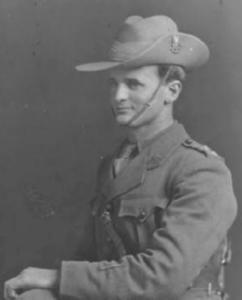As casualties lists from the Gallipoli Campaign became known in Australia from early May 1915, it became a practice to publish a photograph of individuals. These photographs were supplied by the families of the person on the casualty list. There were few photographs published in relation to the number of casualties listed. To give the extent of the human tragedy that unfolded, the photographs were extracted from the various newspapers and placed in this album. Each photograph is clearly identified to an individual and brief details are given as a short biography.
For a comprehensive listing of photographs in the album, see:
Gallipoli Album, May 1915, Contents
Finding service information.
Navigating the National Archives Service File
Should any further details be sought, see Australian Light Horse Studies Centre
Lest We Forget
Studio portrait of Lieutenant (Lt) William Vivian Keats, 52nd Battalion (52 Bn). A clerk from Hobart, Tasmania, he embarked with the 12th Battalion, B Company on 20 October 1914 aboard HMAT Geelong (A2). Keats served as a Lance Corporal at Gallipoli, where he was wounded in his right hand and hospitalised. It was for this injury he received his wound stripe, pictured on his left arm. Following his recovery he was promoted to Corporal and shortly afterwards, to the rank of Sergeant. In 1916 he was transferred to the 52 Bn and appointed to the rank of Lt. On 10 June 1917, whilst waiting for an attack at Messines Ridge, Lt Keats was seriously wounded by an enemy shell. Witness accounts on his service dossier state that he succumbed to his wounds twenty minutes later. Lt Keats is commemorated on the Menin Gate Memorial in Ypres, Belgium.
1007 Lance Corporal William Vivian KEATS, a 24 year old Clerk from McRobie's Gully, Cascade, Hobart, Tasmania. He enlisted on 8 September 1914 and was allotted to the 12th Battalion, B Company which embarked from Hobart, Tasmania, on board HMAT A2 Geelong on 20 October 1914. KEATS subsequently was Wounded in Action, 28 April 1915. During the Great War, KEATS Died of Wounds, 10 June 1917 at Messines, Belgium.









